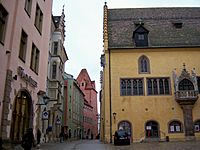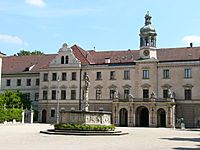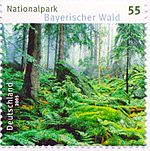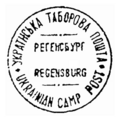Regensburg facts for kids
Quick facts for kids
Regensburg
|
||
|---|---|---|
|
||
| Country | Germany | |
| State | Bavaria | |
| Admin. region | Oberpfalz | |
| District | Urban district | |
| Subdivisions | 18 districts | |
| Elevation | 326 - 471 m (−1,219.3 ft) | |
| Population
(2022-12-31)
|
||
| • Total | 157,443 | |
| Time zone | CET/CEST (UTC+1/+2) | |
| Postal codes |
93001 – 93059
|
|
| Dialling codes | 0941 | |
| Vehicle registration | R | |
| Website | www.regensburg.de | |
|
Imperial City of Regensburg
Reichsstadt Regensburg
|
|||||||||
|---|---|---|---|---|---|---|---|---|---|
| 1245–1803 | |||||||||
| Status | Free Imperial City of the Holy Roman Empire | ||||||||
| Capital | Regensburg | ||||||||
| Government | Republic | ||||||||
| Historical era | Middle Ages | ||||||||
|
• First settled
|
Stone Age | ||||||||
|
• Gained Reichsfreiheit¹
|
1245 | ||||||||
|
• City annexed by Bavaria
|
1486 – 96 | ||||||||
|
• City adopted Reformation
|
1542 | ||||||||
|
• Made permanent seat
of the Reichstag |
1663 – 1806 |
||||||||
|
• Mediatised to new
Archbishopric² |
1803 1803 |
||||||||
|
• Ceded to Bavaria on
Imperial collapse |
1806 |
||||||||
|
|||||||||
|
1: The Bishopric of Regensburg acquired Reichsfreiheit around the same time as the City. Of the three Imperial Abbeys in Regensburg, Niedermünster had already acquired Reichsfreiheit in 1002, St. Emmeram's Abbey did in 1295 and Obermünster in 1315.
2: The Bishopric, the Imperial City and all three Imperial Abbeys were mediatised simultaneously. |
|||||||||
Regensburg is a city in south-east Germany, at the confluence of the Danube, Naab and Regen rivers. With more than 150,000 inhabitants, Regensburg is the fourth-largest city in the State of Bavaria after Munich, Nuremberg and Augsburg. The city is the political, economic and cultural centre and capital of the Upper Palatinate.
The medieval centre of the city is a UNESCO World Heritage Site. In 2014, Regensburg was among the top sights and travel attractions in Germany.
Geography
Topography
Regensburg is situated on the northernmost part of the Danube river at the geological crossroads of four distinct landscapes:
- to the north and northeast lies the Bavarian Forest with granite and gneiss mountains, wide forests and its national park
- to the east and south-east is the fertile Danube plain (Gäuboden) which are highly cultivated loess plains
- the south is dominated by the Tertiary Hill Country, a continuation of Alpine Foreland
- to the West is Franconian Jura
Climate
Regensburg straddles the humid continental (Dfb) and oceanic (Cfb) climate zones under the Köppen climate classification. While the average temperature of 8.5 °C (47.3 °F) in the period from 1971-2000 is slightly above the German average (7.8 °C or 46.0 °F), still only 5 of the 80 cities in Germany above 100000 inhabitants are colder. The average precipitation of 636 millimetres (25.0 inches) per year ranges slightly below the German average (approximately 700 millimetres or 28 inches ). For the newer period from 1981-2010 the average temperature and precipitation rose up to 8.9 °C (48.0 °F) respectively 658 millimetres (25.9 inches). As this increase in the average temperature can also be seen in the other cities, Regensburg still ranks fifth place (shared with Ingolstadt and Kiel) in the above-mentioned ranking. With a total of 1670 sunshine hours per year, Regensburg is roughly 120 hours above German average.
The warmest month of the year, on average, is July. The coolest month of the year, on average, is January.
Main sights
City

Regensburg includes the largest medieval old town north of the Alps with nearly 1,500 listed buildings and a picturesque cityscape. Its most famous sights are located mainly in the Old Town, such as:
- The Dom (Cathedral) is an example of pure German Gothic and is regarded as the main work of Gothic architecture in Bavaria. It was founded in 1275 and completed in 1634, with the exception of the towers, which were finished in 1869. The interior contains numerous interesting monuments, including one of Peter Vischer's masterpieces. Adjoining the cloisters are two chapels which predate the cathedral. One of these, known as the old cathedral, goes back perhaps to the 8th century. The official choir for the liturgical music at St Peter's Cathedral is the famous Regensburger Domspatzen ("cathedral sparrows").
- The stone bridge, built 1135–1146, is a highlight of medieval bridge building. The knights of the 2nd and 3rd crusades used it to cross the Danube on their way to the Holy Land.
- The Regensburg Sausage Kitchen is a major tourist destination, but locals eat there as well. It was originally built as the construction headquarters of the stone bridge and now lies adjacent to it.
- Remains of the Roman fortress' walls including the Porta Praetoria
- The Church of St. James, also called Schottenkirche, a Romanesque basilica of the 12th century, derives its name from the monastery of Irish Benedictines (Scoti) to which it was attached; the principal doorway is covered with very unusual grotesque carvings. It stands next to the Jakobstor, a medieval city gate named after it.
- The old parish church of St. Ulrich is a good example of the Transition style of the 13th century, and contains a valuable antiquarian collection. It houses the diocesan museum of religious art.
- Examples of the Romanesque basilica style are the church of Obermünster, dating from 1010, and the abbey church of St. Emmeram, built in the 13th century, remarkable as one of the few German churches with a detached bell tower. The cloisters of the ancient abbey, one of the oldest in Germany, are still in a fair state of preservation. In 1809 the conventual buildings were converted into a palace for the prince of Thurn and Taxis, hereditary postmaster-general of the Holy Roman Empire.
- The Adler-Apotheke, located nearby the Regensburg Cathedral, was founded in 1610 and is one of the oldest pharmacies in Regensburg. The ancient interior and historical vessels can be viewed.
- Wealthy patrician families competed against each other to see who could build the highest tower of the city. In 1260, the Goldener Turm (golden tower) was built on Wahlenstraße.
- The Old Town Hall, dating in part from the 14th century, contains the rooms occupied by the Imperial Diet from 1663 to 1806.
- The Gasthof zum Goldenen Kreuz (Golden Cross Inn) is also of historical interest: it is where Charles V made the acquaintance of Barbara Blomberg, the mother of Don John of Austria (born 1547).
- Perhaps the most pleasant modern building in the city is the Gothic villa of the king of Bavaria on the bank of the Danube. The grounds are now opened to public and known as VillaPark.
- Among the public institutions of the city are the public library, picture gallery, botanical garden, and the institute for the making of stained glass. The city's colleges (apart from the University of Regensburg) include an episcopal clerical seminary, and a school of church music.
- St. Emmeram's Abbey, now known as Schloss Thurn und Taxis, is a huge castle owned by the powerful Thurn and Taxis family.
- The City Park, the oldest and largest park in Regensburg with a lot of artwork
- The Botanischer Garten der Universität Regensburg is a modern botanical garden located on the University of Regensburg campus.
- Herzogspark also contains several small botanical gardens.
Surroundings
Near Regensburg there are two very imposing Classical buildings, erected by Ludwig I of Bavaria as national monuments to German patriotism and greatness:
- The more imposing of the two is the Walhalla, a costly reproduction of the Parthenon, erected as a Teutonic temple of fame on a hill rising from the Danube at Donaustauf, 10 kilometres (6.2 miles) to the east. The interior, which is as rich as coloured marble, gilding, and sculptures can make it, contains the busts of more than a hundred Germanic worthies.
- The second of King Ludwig's buildings is the Befreiungshalle at Kelheim, 25 kilometres (16 miles) higher up the Danube, a large circular building which has for its aim the glorification of the heroes of the 1813 War of Liberation
Besides, there is the famous Weltenburg Abbey (Kloster Weltenburg), a Benedictine monastery in Weltenburg near Kelheim on the Danube. The abbey is situated on a peninsula in the Danube, on the so-called "Weltenburg Narrows" or "Danube Gorge". The monastery, founded by Irish or Scottish monks in about 620, is held to be the oldest monastery in Bavaria.
To the east of Regensburg lies the Bavarian Forest with its National Park, one of the most visited protected areas in Germany.
Regensburg is on the designated heritage route, the Route of Emperors and Kings.
Images for kids
-
Honorary photo for Pope Benedict XVI in Regensburg Cathedral
-
Johannes Kepler (1610)
-
The Interior of Regensburg Cathedral
-
The Stone Bridge and Regensburg Cathedral by night
-
The Danube seen from the Stone Bridge
-
Monument of Don Juan de Austria
-
Dampfnudel bakery in the Baumburger Turm
See also
 In Spanish: Ratisbona para niños
In Spanish: Ratisbona para niños
































